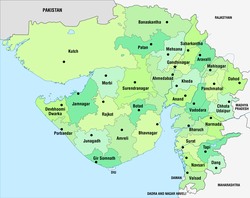| Girnar ropeway | |
|---|---|
 Girnar and city view from ropeway | |
 Interactive map of Girnar ropeway | |
| Overview | |
| Girnar Udankhatola | |
| Character | Recreational |
| Location | Bhavnath Taleti, Junagadh |
| Country | India |
| Coordinates | 21°31′37″N70°30′22″E / 21.52702°N 70.506085°E |
| Termini | Bhavnath Taleti Ambaji Temple |
| Elevation | lowest: 168m highest: 1066m |
| No. of stations | 2 |
| Services | Junagadh, Gujarat |
| Built by | Usha Breco Limited |
| Construction cost | ₹130 crore (US$15 million) [1] |
| Construction begin | September 2018 |
| Open | 24 October 2020 |
| Website | udankhatola |
| Operation | |
| Owner | Usha Breco Limited |
| Operator | Usha Breco Limited |
| No. of carriers | 25 |
| Carrier capacity | 8 passengers |
| Ridership | 8000 daily |
| Trip duration | 7.43 minutes |
| Fare | ₹700 (US$8.30) (normal) ₹400 (US$4.70) (concessional) [1] |
| Technical features | |
| Aerial lift type | Mono-cable gondola detachable |
| Manufactured by | Doppelmayr Garaventa Group |
| Line length | 2,126.40 metres (6,976.4 ft) |
| No. of support towers | 9 [1] |
| No. of cables | 1 |
| Cable diameter | 50 mm |
| Installed power | 1000 kVA |
| Operating speed | 6 m/s |
| Vertical Interval | 900 metres (3,000 ft) [1] |
Girnar ropeway is a ropeway on Mount Girnar in Junagadh district, Gujarat, India. First proposed in 1983, the construction started only in September 2018 due to government approval delays and litigation. The construction and operation is managed by Usha Breco Limited. It was inaugurated on 24 October 2020.


